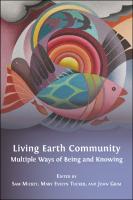Living Earth Community
Multiple Ways of Being and Knowing
| dc.contributor.editor | Mickey, Sam | |
| dc.contributor.editor | Tucker, Mary Evelyn | |
| dc.contributor.editor | Grim, John | |
| dc.date.accessioned | 2020-05-25T10:31:46Z | |
| dc.date.available | 2020-05-25T10:31:46Z | |
| dc.date.issued | 2020 | |
| dc.identifier | OCN: 1156058313 | |
| dc.identifier.isbn | 9781783748037 | en_US |
| dc.identifier.isbn | 9781783748044 | en_US |
| dc.identifier.isbn | 9781783748068 | en_US |
| dc.identifier.isbn | 9781783748075 | en_US |
| dc.identifier.isbn | 9781783748082 | en_US |
| dc.identifier.uri | http://library.oapen.org/handle/20.500.12657/39359 | |
| dc.description.abstract | "Living Earth Community: Multiple Ways of Being and Knowing is a celebration of the diversity of ways in which humans can relate to the world around them, and an invitation to its readers to partake in planetary coexistence. Innovative, informative, and highly accessible, this interdisciplinary anthology of essays brings together scholars, writers and educators across the sciences and humanities, in a collaborative effort to illuminate the different ways of being in the world and the different kinds of knowledge they entail – from the ecological knowledge of Indigenous communities, to the scientific knowledge of a biologist and the embodied knowledge communicated through storytelling. This anthology examines the interplay between Nature and Culture in the setting of our current age of ecological crisis, stressing the importance of addressing these ecological crises occurring around the planet through multiple perspectives. These perspectives are exemplified through diverse case studies – from the political and ethical implications of thinking with forests, to the capacity of storytelling to motivate action, to the worldview of the Indigenous Okanagan community in British Columbia. Living Earth Community: Multiple Ways of Being and Knowing synthesizes insights from across a range of academic fields, and highlights the potential for synergy between disciplinary approaches and inquiries. This anthology is essential reading not only for researchers and students, but for anyone interested in the ways in which humans interact with the community of life on Earth, especially during this current period of environmental emergency. " | en_US |
| dc.language | English | en_US |
| dc.subject.classification | thema EDItEUR::R Earth Sciences, Geography, Environment, Planning::RN The environment | en_US |
| dc.subject.classification | thema EDItEUR::R Earth Sciences, Geography, Environment, Planning::RN The environment::RNT Social impact of environmental issues | en_US |
| dc.subject.classification | thema EDItEUR::R Earth Sciences, Geography, Environment, Planning::RN The environment::RNA Environmentalist thought and ideology | en_US |
| dc.subject.classification | thema EDItEUR::J Society and Social Sciences | en_US |
| dc.subject.classification | thema EDItEUR::P Mathematics and Science::PS Biology, life sciences::PSA Life sciences: general issues::PSAF Ecological science, the Biosphere | en_US |
| dc.subject.other | Earth | en_US |
| dc.subject.other | environment | en_US |
| dc.subject.other | scholars | en_US |
| dc.subject.other | ecosystems | en_US |
| dc.subject.other | ecological knowledge | en_US |
| dc.subject.other | scientific knowledge | en_US |
| dc.subject.other | ecological crisis | en_US |
| dc.title | Living Earth Community | en_US |
| dc.title.alternative | Multiple Ways of Being and Knowing | en_US |
| dc.type | book | |
| oapen.identifier.doi | 10.11647/OBP.0186 | en_US |
| oapen.relation.isPublishedBy | 23117811-c361-47b4-8b76-2c9b160c9a8b | en_US |
| oapen.collection | ScholarLed | en_US |
| oapen.pages | 286 | en_US |

